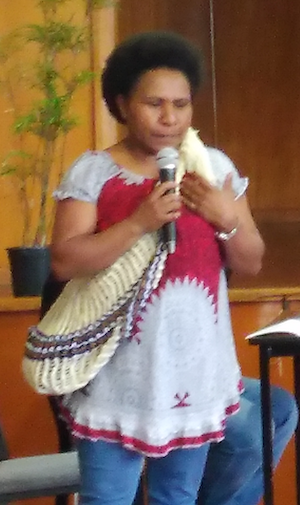Florence Jaukae works with a co-operative of women in Papua New Guinea to produce original works of bilum. Video: Pacific Trade Invest Australia
By Laurens Ikinia
Papua New Guinean academics and community leaders in Aotearoa New Zealand tackle their concerns about climate change and mental health issue in the Pacific through a traditional and famous craft – weaving bilums.
The Papua New Guinea cultural language week was held by the PNG Community Trust in Manawatu region at Rangiora Community Hall in Palmerston North late last year.
Bilum-making was introduced to the audience through a presentation by Dr Hennah Steven who recently completed her doctorate in development studies from Massey University.
Dr Steven described the bilum as a handcrafted bag that had been passed down from generation to generation, saying it was a craft that the women in PNG and other Melanesian societies did in their leisure time.
She said a bilum was one of the “famous items” carried everywhere in PNG.
“It is a women’s leisure activity, where we normally sit down and make bilum,” she said.
“Bilum was also a cultural element. If you go to PNG, everywhere people carry at least one bilum – from a little child to young people and to old people – they always carry a bilum.”
Special occasions
Dr Steven said that the bilum had several purposes, so during casual occasions people carried a small one. On special occasions – like at a funeral – people used longer ones that were made of traditional materials such as tulip tree and sisal fibre.
Following the presentation, skilful women – and men – bilum-weavers from Manawatu PNG’s community gave a display.
 Dr Hennah Steven … “In PNG, everywhere people at least carry one bilum.” Image: Laurens Ikinia
Dr Hennah Steven … “In PNG, everywhere people at least carry one bilum.” Image: Laurens Ikinia
Dr Steven, Dr Stephanie Sageo-Tapungu, who completed her doctorate in communication studies at Auckland University of Technology, and the event organiser Paul Titus, the PNG community trust chairman in the Manawatu region, shared their insights about bilums.
They described bilums as having ancestral values and that they were a sign of Melanesian identity.
Bilums are not only used in PNG and across the Pacific, but are also used by people from countries such as Australia, New Zealand, the UK, the USA with Melanesian or Pacific experience.
“Palmerston North – we are the ones doing this thing and we also have done different things in many ways,” said Paul Titus.
According to him, the aim of the event was “to showcase the bilum-making by using PNG language” so that people could be educated about PNG culture.
Teaching younger people
Also it was hoped to be able to teach younger people about bilum-making and the benefits.
Titus said bilum-making was connected to language and participants chose to demonstrate this.
Dr Sageo-Tapungu said bilums represented the foundation of society and womanhood.
“Babies sleep in the bilum because its design is similar to that of the womb. Food and firewood is carried in a bilum. We adorn our bodies with bilums during our traditional celebrations,” she said.
“Bilums are given as gifts to our precious loved ones. We carry our most precious possessions in the bilum and we do not open another person’s bilum because we do not want to invade their privacy.
“It represents our Melanesian worldview and is sacred and precious.”
The bilum display at Rangiora Community Hall, Palmerston North. Image: Laurens Ikinia
Dowry for women
Dr Tapungu added: “To me, a bilum is also a form of dowry for women. When a woman gets married, she is adorned with bilums and she takes that to her groom.”
“Likewise, the groom is also adorned with bilums to given to his bride as gifts.
“Bilums are hung over a deceased person’s coffin or body to show that the spirit will have something precious to carry when entering the spirit world.”
Paul Titus, who has been living in New Zealand since 2003 and frequently visits his home country, said bilum-making had a great benefit over health issues, particularly mental health.
Women came together and while making or crafting bilum, they are able to share their stories, he said. Thus, they would feel relief from the stress of any problem that they were going through.
Laurens Ikinia is a Papuan Masters in Communication Studies student at Auckland University of Technology who has been studying journalism. He contributes to Asia Pacific Report.
 Bilum-weaving at the Palmerston North event … part of the Melanesian world view. Image: Laurens Ikinia
Bilum-weaving at the Palmerston North event … part of the Melanesian world view. Image: Laurens Ikinia
APR editor | Radio Free (2021-03-02T19:05:21+00:00) Papua New Guinea’s bilum – how the handcrafted bags reached Rangiora. Retrieved from https://www.radiofree.org/2021/03/02/papua-new-guineas-bilum-how-the-handcrafted-bags-reached-rangiora/
Please log in to upload a file.
There are no updates yet.
Click the Upload button above to add an update.

